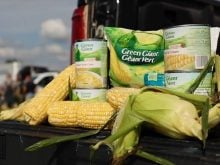[AUDIO: Listen to John Greig, editor of Farmtario, talk with Don Kabbes, general manager of Great Lakes Grain about corn and soybean yield projections.]
[UPDATE: Sept. 14, 2020] Ontario is in line for a record soybean crop.
That’s the result from the recent Great Lakes Grain yield tour.
The 11th edition of the tour, which looks at crops from Windsor to the Ottawa Valley, assesses corn and soybean yield and gives individual farmers report cards on their projected yields. Results were released Sept. 9.
Read Also

Women who fed a nation
More than 40,000 young women supported the war effort between the 1940s and early 1950s, helping grow and harvest crops amid labour shortages. They were called Farmerettes.
Why it matters: Yield estimates help farmers plan and the trade get ready for the coming harvest.
This year the tour visited 538 corn fields and 421 soybeans fields.
Here are some of the take-aways from the tour:
Soybeans
- Great Lakes Grain is calling for an average yield of 58.3 bushels per acres on soybeans, which would be an Ontario record.
- Great Lakes Grain staff has used used 2.4 soybeans per pod as its average number in its calculations for 10 years but this year that’s to 2.6 soybeans per pod.
- There are more pods per plant, plants per row and seed size is also expected to be larger.
“Even though we are estimating a stellar soybean yield with the incidences of root rots and nutritional issues, it just means there is even is more yield being left unrealized in your fields,” says Dale Cowan, agronomy strategy manager and senior agronomist at AGRIS and Wanstead Co-operatives.
Corn
The Great Lakes Grain tour is calling for an average bushels per acre of 186 for corn.
- Corn heat unit accumulation in southwestern Ontario as of Sept. 5 was six full days ahead of a year ago and four days ahead of the 30-year trend.
- Black layer for corn will be at the end of September or early October.
- Last year at this time 22 per cent of the corn was in dent stage, versus this year at 54 per cent.
- Cold weather in may knocked back corn plant populations due to poorer emergence.
*Update: An incorrect soybean yield number was previously stated.















